#inspired by the music by John and yoko
Explore tagged Tumblr posts
Text
WAR IS OVER: INSPIRED BY THE MUSIC OF JOHN AND YOKO
Carrier pigeon
Sparks chess game between soldiers
From opposing sides
youtube
#war is over#inspired by the music by John and yoko#random richards#poem#haiku#poetry#haiku poem#poets on tumblr#haiku poetry#haiku form#poetic#short film#animated short#dave mullins#sean ono lennon#john lennon#yoko ono#happy xmas#Youtube
1 note
·
View note
Text
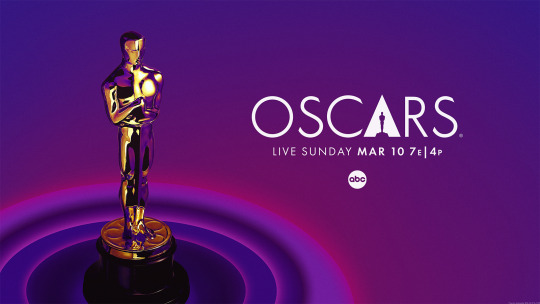
Oscars 2024 winners:
Best Picture – Oppenheimer
Best Actress in a Leading Role – Emma Stone, Poor Things
Best Directing – Christopher Nolan, Oppenheimer
Best Actor in a Leading Role – Cillian Murphy, Oppenheimer
Best Original Song – “What Was I Made For?” by Billie Eilish and Finneas O'Connell, Barbie
Best Original Score – Ludwig Göransson, Oppenheimer
Best Sound – Tarn Willers and Johnnie Burn, The Zone of Interest
Best Live Action Short Film – The Wonderful Story of Henry Sugar
Best Cinematography – Hoyte van Hoytema, Oppenheimer
Best Documentary Feature Film – 20 Days in Mariupol
Best Documentary Short Film – The Last Repair Shop
Best Film Editing – Jennifer Lame, Oppenheimer
Best Visual Effects – Takashi Yamazaki, Kiyoko Shibuya, Masaki Takahashi and Tatsuji Nojima, Godzilla Minus One
Best Actor in a Supporting Role – Robert Downey Jr., Oppenheimer
Best International Feature Film – The Zone of Interest (United Kingdom)
Best Costume Design – Holly Waddington, Poor Things
Best Production Design – Production Design: James Price and Shona Heath; Set Decoration: Zsuzsa Mihalek, Poor Things
Best Makeup and Hairstyling – Nadia Stacey, Mark Coulier and Josh Weston, Poor Things
Best Adapted Screenplay – Cord Jefferson, American Fiction
Best Original Screenplay – Justine Triet and Arthur Harari, Anatomy of a Fall
Best Animated Feature – The Boy and the Heron
Best Animated Short Film – War Is Over! Inspired by the Music of John & Yoko
Best Actress in a Supporting Role – Da'Vine Joy Randolph, The Holdovers
#Oscars 2024#Oscars#Oppenheimer#Poor Things#The Zone of Interest#American Fiction#Anatomy of a Fall#Barbie#The Boy and the Heron#Godzilla Minus One#The Holdovers#The Last Repair Shop#20 Days in Mariupol#War Is Over! Inspired by the Music of John and Yoko#The Wonderful Story of Henry Sugar#film#awards
43 notes
·
View notes
Text

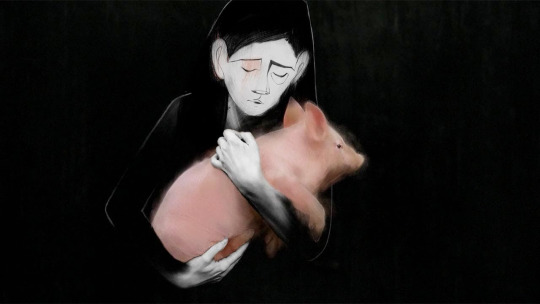

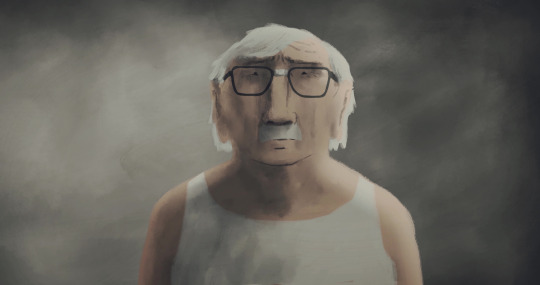

Best Animated Short Film Nominees for the 96th Academy Awards (2024, listed in order of appearance in the shorts package)
This blog, since 2013, has been the site of my write-ups to the Oscar-nominated short film packages – a personal tradition for myself and for this blog. This omnibus write-up goes with my thanks to the Regency South Coast Village in Santa Ana, California for providing all three Oscar-nominated short film packages.
If you are an American or Canadian resident interested in supporting the short film filmmakers in theaters (and you should, as very few of those who work in short films are as affluent as your big-name directors and actors), check your local participating theaters here.
Without further ado, here are the nominees for the Best Animated Short Film at this year’s Academy Awards. The write-ups for the Documentary Short and Live Action Short nominees are complete. Films predominantly in a language other than English are listed with their nation(s) of origin.
Yet again, this completes this year’s omnibus write-ups for the Oscar-nominated short films for the upcoming Academy Awards:
Our Uniform (2023, Iran)
Director Yegane Moghaddam used to be a primary school teacher in Iran and often “observed the students… struggling with their uniforms and headscarves all day.” These observations informed her film and narration in Our Uniform, which won Best First Film at Annecy (the largest animation-only film festival, in the French Alpine resort town of the same name) in 2023. Only the fourth ever non-Western/European and non-Japanese nominee in this 92-year-old category – following 2014’s Bear Story (Chile; that year's winner), 2020’s Opera (South Korea) and 2021’s Bestia (Chile) – Our Uniform adopts a unique style never before seen in this category. Instead of traditional cel animation with ink and paper or computers, Moghaddam nearly single-handedly painted images directly on clothing fabrics (pants, jackets, shirts, scarves – all from her personal wardrobe) to illustrate the memories her narration shares. These memories, of attending public school in Iran, invariably intersect with Iran’s theocratic politics. There are references, never pedantic, about government propaganda as part of the school curriculum, and the segregation between boys’ and girls’ education. Most vividly, Moghaddam remarks on the restricting school uniform and compulsory hijabs for girls at school, issues which enflamed protests against such laws beginning in 2017 (and spiking after the death of Mahsa Amini in 2022).
Moghaddam, who cites graphic novelist/director Marjane Satrapi (2007’s Persepolis, 2011’s Chicken with Plums; the former I consider among the finest animated films of this young century) as her primary artistic inspiration, curiously does not contain as much messaging in her film as one might expect. As an Iranian citizen who currently has no plans to officially distribute the film within her home nation due to fear of retribution, how could she? But the film’s slightness cannot distract from its painstaking, loving artistry. Without relying on inventive camerawork, Moghaddam uses the natural pockets and folds of her clothes to suggest dimension and personality. To Moghaddam, all clothing has a personality and personal history to the wearer, even compulsory clothing, all of which she uses to wonderful effect. What originally began as a fun side project that Moghaddam had no expectations for gifts audiences a truly original viewing experience.
My rating: 7.5/10
Letter to a Pig (2022, Israel/France)
Qualifying for the Academy Awards after winning the Grand Prize for Best International Short Film at Anima, the Brussels Animation Film Festival, in early 2023, Nal Kantor’s Letter to a Pig sees a Holocaust survivor retelling a story of survival to a group of largely disinterested and scornful teenagers. As the elderly man recounts how he wrote a letter to a pig that inadvertently saved his life, a handful of students start insensitively snorting. Quietly, Letter to a Pig adopts the standpoint of one of the girls in class, half-listening at first. Here, Kantor seamlessly switches between the man’s memories and the reality of the classroom, through heavy rotoscoping to outline her figures, mixing it with live-action footage for the limbs or eyes, but only using a few ink scribbles to outline facial features and hair. Generally, the more movement either the schoolgirl or Holocaust survivor show, the more scribbles and live-action footage that appear. For all other figures, they remain mostly abstract.
As a young man, the Holocaust survivor recalls how filled with rage he was, long after his near-death encounter. Now, physically unable to exact retribution on those who harmed him, he tells the students “you are my revenge” – passing along his trauma to those not realizing what they have just received. The schoolgirl’s vision in the surrealistic final minutes is her absorption of the Holocaust survivor’s story. This masterfully drawn finale is the emotional apex of Letter to a Pig, fully justifying its black-and-white palette (with one exception: pink for the pigs, considered an impure animal in Judaism) in service for its profound sense of dread. Symbolizing memory, the pig appears throughout the film as a savior, a monster, or something worthy of mockery, depending on who is on screen. It is in these final moments Letter to a Pig leaves the audience with pressing questions. Can one impart painful memories without the trauma that gives such memories form? Most urgently, can we choose not to act on the trauma we inherit? May it be possible not only in dreams.
My rating: 8.5/10
Pachyderme (2022, France)
Stéphanie Clement’s Pachyderme, like Letter to a Pig, is an unsettling short film that delves deeply into the mind of a troubled character. In this film, a young woman named Louise (Christa Théret) recalls her days visiting her grandparents in Provence (southeastern France) during her childhood. The sun-bathed rural landscape is picturesque, the grandparents’ house gorgeously stylized. Beyond this, some of Louise’s recollections feel incomplete, with no apparent structure or chronology. That might read as a criticism, but Clement and screenwriter Marc Rius fully intend for Pachyderme to seem fragmented. The film strongly implies – and some viewers will pick this up earlier or later than others – that the grandfather sexually abused Louise. In reaction, Louise, while recounting her memories for the audience, has repressed her memories and is showing signs, in her narration and in her visual recollections, of disassociation. I do not recall ever seeing disassociation, a common symptom of those who have been sexually abused, portrayed as cinematically as seen in Pachyderme. It is best exemplified, metaphorically, in the scene where our protagonist disappears into the wallpaper (this scene was originally the first bit of test footage made for the film).
But perhaps there is no better visualization of all Pachyderme has to say than the moment where Louise’s grandfather notices her index finger bleeding. He grasps her hand, and his hands dwarf hers. The simultaneity of Pachyderme’s picture book visuals and its horrifying implications show the viewer a woman who has not fully processed what has happened to her. It is not helped by the defensiveness of Louise’s grandmother following the grandfather’s death. Family denial, too, is playing a role in how Louise is choosing, consciously and subconsciously, to remember the past. In its eleven minutes, Pachyderme passes in a dreamlike haze, its illusory moments enabling the viewer to more closely connect to Louise’s (both the young adult narrating the film and the child on-screen) feelings. Unlike many nominees in Best Live Action Short Film down the years that addressed childhood trauma (it's a long-running trend for that category), Pachyderme prioritizes healing in as cinematic a way as possible.
My rating: 8.5/10
Ninety-Five Senses (2023)
If the names Jared and Jerusha Hess are familiar, that is because this husband-and-wife directorial team also made Napoleon Dynamite (2004) and Nacho Libre (2006). Some of those same comedic sensibilities carry over to Ninety-Five Senses, which qualified for the Academy Awards by winning Best Animated Short at the Florida Film Festival in 2023. The film features an old man named Coy (Tim Blake Nelson, a Coen Brothers regular whose voice fits the narrative here) reflecting back on life – a reverie that jumps, hops, and skips across time and place. At first, Ninety-Five Senses, with its wildly shifting style changes, does not seem to have much of a point or purpose. But the film gradually reveals itself: first through the subtle shading of what appear to be prison bars and, later, the mountain of discarded food cartons sitting on the table in front of Coy. We soon realize that Coy is in the final hours or minutes of being on death row, and he is describing to the audience his internal peace before he meets his fate.
Ninety-Five Senses is not here to make a point about capital punishment, incarceration, or the terrible actions that landed Coy in prison. Foremost, this is a film that attempts to capture the last gasp of humanity of an individual before their execution. In contrast with the drab grays whenever Coy is seen in his cell, his flashbacks are intense – a fount of color, with both crude and elegant character designs, hand-drawn and computer-generated (sometimes appearing side-by-side). Not every vignette – of which there are five, one for each human sense – showcases as much aesthetic excellence as the others, such as an early instance where Coy recounts his childhood. That vignette does not evoke the respective human sense it covers as well as it thinks it does; the art style of that vignette also recalls hand-drawn television animation, but flows too smoothly to exactly replicate it. In any case, this is a promising first foray into animated film for the Hesses.
My rating: 8/10
War Is Over! Inspired by the Music of John and Yoko (2022)
War Is Over! (you cannot make me write or say the full title ever again) has the basics of a promising animated short film. Yet its simplistic take on humanity and warfare and close association with John Lennon and Yoko Ono’s “Happy Xmas (War Is Over)” condemns the film as pure hogwash. On second thought, I retract “hogwash”. That is an insult to Letter to a Pig and to porcine animals. This is self-congratulatory treacle from director Dave Mullins and co-writer Sean Ono Lennon (the son of John and Yoko). In a supposedly alternate World War I reality, a pigeon delivers messages between an Allied and a Central Power soldier on opposite sides of No Man’s Land. The messages contain chess notation, as they, somehow, began a game of chess with each other without ever meeting. One day, at presumably Christmas, the two armies inexplicably charge toward each other and, amid gunfire and a mass mêlée that should leave many more soldiers dead than shown, our two soldiers encounter each other on the battlefield in combat shorn of its gruesomeness.
Despite the film using the Unreal Engine for its animation, I admire the film’s lighting effects, character movements, pigeon animation, sound effects, and art direction for the otherwise sanitized trenches. That may be all the positives I can offer.
The contrived scenario sinks even further when our two chess-playing soldiers discover a critical message from their pigeon messenger. Cue the second-most embarrassing needle drop among this year’s fifteen short film nominees (somehow, the closing moments of The After are worse than this). Unlike The After, War Is Over! feels as if constructed around its respective song. Is this now a glorified music video? In an instant, the film reduces the tragedy of the Great War to something akin to a soft drink commercial or that “Imagine” video (could we stop disrespecting John Lennon and his fellow Beatles?). The sanitized depiction of war and farfetched resolving actions undercut the film’s message, embarrassing itself as it lurches through its excruciating final minutes. That the first credit in the end credits read “music and message by John and Yoko” rather than director Dave Mullins leaves an even more sour taste. At the heart of War Is Over!, Mullins and Sean Ono Lennon want us to know that war is bad. I never could have guessed!
My rating: 4/10
^ Based on my personal imdb rating. My interpretation of that ratings system can be found in the “Ratings system” page on my blog. Half-points are always rounded down.
From previous years: 85th Academy Awards (2013) 87th (2015) 88th (2016) 89th (2017) 90th (2018) 91st (2019) 92nd (2020) 93rd (2021) 94th (2022) 95th (2023)
Two other films played in this package as honorable mentions: Wild Summon (2023, dir. Karni Arieli and Saul Freed; 6/10) and I'm Hip (2023, dir. John Musker; 6/10).
For more of my reviews tagged “My Movie Odyssey”, check out the tag of the same name on my blog.
#Our Uniform#Letter to a Pig#מכתב לחזיר#Pachyderme#Ninety Five Senses#Ninety-Five Senses#War Is Over!#War Is Over! Inspired by the Music of John and Yoko#Yegane Moghaddam#Tal Kantor#Stéphanie Clément#Jared Hess#Jerusha Hess#Dave Mullins#Sean Ono Lennon#Tim Blake Nelson#96th Academy Awards#Oscars#31 Days of Oscar#My Movie Odyssey
7 notes
·
View notes
Text
youtube
“WAR IS OVER! Inspired by the Music of John & Yoko” Gets Oscar Nomination
- Animated short is showing in select theaters in package with other nominees
A 53-year-old song inspired a short film that is now up for a 2024 Oscar.
The animated short is titled “WAR IS OVER! Inspired by the Music of John & Yoko” and based loosely around 1971’s “Happy Xmas (War is Over!).” But this 11-minute film focuses not on the main title, but rather, its parenthetical subtitle.
“This is an anti-war song; it’s a protest song,” writer and director Dave Mullins said in a making-of featurette for the film. “It’s why we didn’t make a Christmas or holiday short - we made an anti-war short.”
There’s no dialogue as “WAR IS OVER!” tells the story of soldiers on opposing sides of a fictionalized battlefield playing a surreptitious game of chess via carrier pigeon as the fighting rages. The filmmakers had trouble finding a place for the title song - executive producer Sean Ono Lennon had no interest in making a traditional music video for such a well-known number - so it runs over the credits. Thomas Newman composed the score, which Mullins said serves “as the emotional voice of the characters.”
youtube
Lennon said he wanted to “do good by (his parents’) art” in working on the short.
“What I don’t want,” he later told The New York Times, “is for my mother and father’s work to disappear with the sands of time.”
Not yet streaming, “WAR IS OVER! Inspired by the Music of John & Yoko” is showing in select North American movie houses in package screenings with other Oscar nominees in the Animated Short Film category.
3/2/24
#Youtube#war is over! inspired by the music of john & yoko#happy xmas (war is over!)#john lennon#yoko ono#sean ono lennon#dave mullins#thomas newman#the beatles#the new york times
5 notes
·
View notes
Text
All Short Films Nominated at The 96th Academy Awards
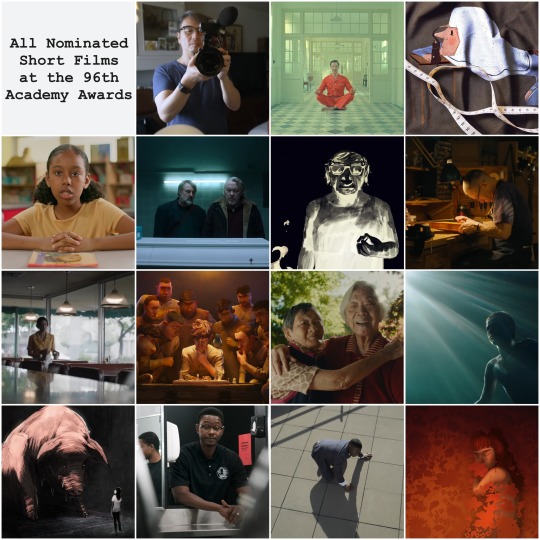
#Island in Between#The Wonderful Story of Henry Sugar#Our Uniform#The ABCs of Book Banning#Knight of Fortune#Ninety-Five Senses#The Last Repair Shop#Red White and Blue#War Is Over!#War Is Over! Inspired by the Music of John and Yoko#Nǎi Nai & Wài Pó#Invincible#Letter to a Pig#The Barber of Little Rock#The After#Pachyderme#movie mosaics#96th Academy Awards#Academy Awards#Oscars#Oscars 2024#Best Documentary Short Subject#Best Live Action Short#Best Animated Short
3 notes
·
View notes
Text
WHAT IS THAT MELODY??? Some back story: In the mid 70s, John went on hiatus from making music in order to be a house husband and take care of his new son while yoko worked. At the end of the 70s john slowly became inspired to get back into music. One of his stranger inspirations was the song "Rock Lobster" by the B-52s. Another inspiration being almost dying on a sailing trip in the Bermuda triangle, but that's a story for another day.



149 notes
·
View notes
Text

#TastyTuesday
On this day in 1960, The Beatles (John, Paul, George, and Ringo) recorded music for the first time together at Akustik Studio. I’m sure they had no idea then what their legacy would become, such as inspiring a pun-filled cookbook seen here. She Came in Through the Kitchen Window by Stephen J. Spignesi (Szathmary TX714 .S638 2000) is chock-full of recipes inspired by the Fab Four and their music, including “Can’t Buy Me Fudge”, “The Scallops of John and Yoko”, and “Turkey to Ride”. Intermixed with photos and interesting anecdotes, this is a real treat for any Beatlemaniacs out there, or maybe just those who need some recipe inspiration.
-Kaylee S., Olson Graduate Research Assistant



#uiowa#libraries#special collections#tasty tuesday#the beatles#recipes#paul mccartney#george harrison#john lennon#ringo starr
104 notes
·
View notes
Text
After lunch, we all returned to the Dakota, where I hoped the repartee might become somewhat more sparkling. Yoko and Linda paired off for a bit and chatted amiably—the two of them got along famously, bonded by the shared experience, perhaps, of being married to a Beatle—while John and Paul stood by the windows overlooking Central Park, watching as the afternoon sky turned a whiter shade of pale over Manhattan. They remained silent for long stretches, until awkwardness forced one of them to take a stab at conversation.
“Are you making any music?” Paul asked at one point.
“Well, you know, I play some stuff for me, but I’m not working on anything. Music isn’t what’s driving me at this point. It’s all about the baby. What about you?”
“Oh, I’m always recording,” Paul said. “I couldn’t live without the music in me life.”
Then, for a spell, they fell back into silence.
It seemed that these two rock ’n’ roll behemoths, men who in their youth had all but defined the zeitgeist of the ’60s—who had inspired an entire generation and redirected music’s very destiny—were now, a mere decade later, struggling to find things to say to each other.
A part of me found it sad. But then, what was I expecting? Even the best of childhood friends eventually slip into separate lives. It’s called growing up. Now they were just two old chums who no longer had all that much in common. It was unreasonable of me to presume that merely being in the same room together would somehow ignite the genius and energy of John and Paul’s initial creative partnership.
Still, on the walk back from the Dakota to the Plaza that evening, as I passed all the glimmering Christmas lights and heard snippets of holiday melodies wafting out of the few restaurants and bars that were still open and serving, I couldn’t help but think that history might have been made on this day.
“Are you making any music?” Paul had asked John.
What if John had said something like “No, but me guitar is in the next room. Let’s sit down and make some…”
God only knows what classic Lennon-McCartney creation might have been born that afternoon.
Excerpt From ‘We All Shine On’, Elliot Mintz
#yep he’s entered the fix-it fic phase#I hate the way mintz uses ‘me’ instead of ‘my’ throughout this book#the first rule of beatles fanfic - don’t try to write the accent#john lennon#paul mccartney#john and paul#elliot mintz
103 notes
·
View notes
Text
John was being honest when he described himself as dead lazy, and so having a partner and bff like Paul was perfect for him since Paul is such a workaholic and can hardly sit still.
John needed a push, someone who could carefully and patiently nudge and drive him along, or at least light the fire under his butt, because if not he could become listless, lethargic, and stuck. I'd say this was pretty obvious during the 70s.
Paul was perfectly suited for John in this, like in so many other ways too. Paul seemed not at all bothered, but quite comfortable with this position in their relationship, as far as I can tell. I'm thinking back to Paul making his way to John's house in Kenwood, that he'd often have to wake John up, this involving cups of tea or coffee. Maybe they did some writing and playing, maybe they didn't, as Paul said it was his way to get out of London.
Or, how Paul, John, and Ringo (sans George) had to do a Christmas recording, and how Paul, the whole time, was gently and patiently urging John on to just do it.
I think they're a perfect encapsulation of their relationship, these moments and memories caught.
They both gave each other a harmless need to compete, and to accomplish, together. I mean I'm sure there were plenty of times Paul's patience wore thin with John, and I'm sure John was very intentional in needling that, but insofar that I can tell, Paul really did have exceedingly, almost near limitless patience and love for John as both a partner and a friend.
John needed that, he needed someone like Paul, who could truly and unapologetically put up with him, and love him, and still want to work with him every day, day and night.
Even when the band broke up, the divorce finalized, and John was both loving and hating Paul in tandem for the next ten years... Paul was desperate to write with John again, and John was desperate just to write, you see.
PLAYBOY: But wasn’t it clear that John wanted only to work with Yoko?
LINDA: No. I know that Paul was desperate to write with John again. And I know John was desperate to write … desperate. People thought, Well, he’s taking care of Sean, he’s a house-husband and all that, but he wasn’t happy. He couldn’t write and it drove him crazy. And Paul could have helped him—easily.”
— Linda on John and Paul in the late 70’s and 1980. (X)
While Yoko was definitely driven and career oriented, that didn't necessarily mean she influenced, inspired, or drove John on herself. Not in the way Paul did. I think that's pretty evident, considering he subsumed himself to "house husband", only occasionally baking bread before even that lost his interest, in which he'd keep to lazing about, sleeping hours on end, and mindlessly watching tv.
John was no house husband, the role he took with Yoko was pretty far removed from his potential, even with Cynthia it wasn't that bad.
With Paul, John even thought of writing musicals, and he apparently wasn't even that fond of musicals—but if Paul wanted to do it, like so many other things, then why couldn't John? If John had Paul, then he could do just about anything and everything, really.
“MM: In the early days, did John and Paul really write together?
MARTIN: Yes, but they also wrote separately. “Please Please Me” and “From Me To You” and “I Want To Hold Your Hand” were undoubtedly collaborative efforts. They’d sit down and literally construct the songs together. I can’t remember the first individual songs, although obviously even before I met them they were writing individually, but if you go through them you can hear which of them are John-oriented and which are Paul-oriented. “Yesterday” is obviously Paul, and that’s an interesting point because it was the first time we ever used anyone other than Beatles on a record. There was no one on that record but Paul and a string quartet.
MM: Did you notice them growing apart, developing distinct personalities?
MARTIN: Paul and John had their own identifiable styles: Paul was the syrupy one and John was the hard one. But the rift wasn’t there then. They were really a unit.
MM: Could you tell me what you think of what each one has done individually since the last Beatles record?
MARTIN: I have great admiration for George. He’s done tremendously because it’s a sort of devotion to duty as far as he’s concerned. We forced him into being a loner, I guess … he could never collaborate with anybody in his writing and therefore when the split came he had more strength because he was forced to be alone. He learned an awful lot about producing, studio techniques, and so on, so that he was able … obviously, any one of them had the power - because they had the money - to spend as much time in the recording studio as they liked, and I know that when George made his album he spent six months doing nothing but overdubbing his own voice 16 times and producing his album. To have the tenacity to do that in itself is something of an achievement, but to go along and actually produce good sounds and good music and good lyrics with it is tremendous. I’m full of admiration for that.
I think the other two have suffered by comparison, because they’ve each indulged themselves in their own way. John’s become more obvious in a way … “Power To The People” is a rehash of “Give Peace A Chance,” and it isn’t really very good. It doesn’t have the intensity that John’s capable of. Paul, similarly with his first album … it was nice enough, but very much a home-made affair, and very much a little family affair. I don’t think he ever really rated it as being as important as the stuff he’d done before.
I don’t think Linda is a substitute for John Lennon, any more than Yoko is a substitute for Paul McCartney.”
— George Martin, Melody Maker Interview, 1971. (X)
John was very partner orientated. He needed someone, whether he liked it or not, and he needed them to need him too.
He didn't like being a husband, but he liked having a wife, someone there for him constantly, who loves him and will care for him. John had Cynthia for that, at the start. John had Pete as his partner in crime, bestest of mates, when they were just kids.
Then, John had Paul, and turns out, Paul just about covered all of that, too, and plus it. A best friend, a coconspirator, a wife, a collaborator, his partner, his rival and his greatest ally and muse. Cherry on top, Paul needed John just as badly, madly. Maybe John never saw it that way, maybe that was why he had his fear, his insecurity that Paul never really needed him as much as John needed him.
“IRVIN: Back then people were very keen on knowing who the leader of the group was…
GEORGE M.: Yes, I was. When I first auditioned them I said, “Who’s going to be the leader, is it John or Paul?” Such an odd couple really, because they were diferent and yet very similar, both had big egos, both very good songwriters, but they needed each other like mad.
IRVIN: Did they really like each other? It wasn’t just a competitive partnership.
GEORGE M.: Oh no, they loved each other! They were brothers, and like brothers they pissed each other off quite a lot. John could be maddening at times, Paul can be very bossy and even more maddening and George would get fed up with both of them. But they did love each other and adored what the other did and had an incredible bond.
Paul always took inspiration from John, especially in his lyric-writing. ‘Eleanor Rigby’, for example, wouldn’t have happened without John’s influence. Paul wrote all of it but John’s influence was there and similarly John was knocked out by the freshness Paul brought to melodies and harmonies. He learnt from Paul how to put in the odd chord that choked you up a bit.”
— George Martin, interview w/ Jim Irvin for Mojo: Sir George Martin: The Mojo interview. (March, 2007) (X)
I think I've gone off tangent, but the point of this was to say, John was dead lazy, vastly intelligent and talented, but very prone to sloth. Paul was a rather perfect stopper to that. He could whip John up, get him moving, shaking, ever patient and ever loving, just the right enough of mean, bitchy and stubborn, smart and quick tongued, to meet John toe-to-toe. Like a house on fire these two fired each other up, talk about all-consuming and intense.
They were pretty perfectly matched for each other.
“It was like a tug of war. Imagine two people pulling on a rope, smiling at each other and pulling all the time with all their might. The tension between the two of them made for the bond.”
— George Martin on Lennon/McCartney (X)
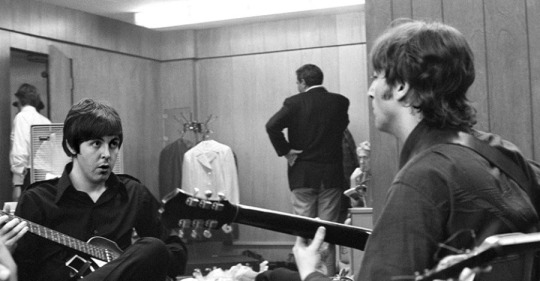
378 notes
·
View notes
Text
Paul on Eat At Home
Nobody was writing simple and easy-to-follow recipe books for meat free home cooking. So, eating in bed was something we both really liked to do. There were a couple of other things we really liked to do, but that’s for another day. It’s a very different take on domesticity from that ‘Bed-In for Peace’ that John and Yoko had in a hotel room in Amsterdam in 1969. Right from the start, he and I were always bouncing off each other when it came to subjects for songs. But the world represented here is certainly much quieter, conducted without the world’s press. You have to remember that Linda and I were newly married, with a baby, and we were desperately trying to escape the hurly-burly and just find time to be a family. We were completely cut off on our farm in Scotland, a place I’d bought a few years before but Linda really fell in love with. So we just made our own fun. We drew a lot. We wrote a lot. We inspired each other. <many beautiful and touching words about lovely life with lovely Linda> From a musical perspective, ‘Eat at Home’ owes much to the example of Buddy Holly, a huge influence on The Beatles when we were growing up and starting to write our own songs. One of the aspects I rather enjoy is that I modified Buddy Holly’s tendency to mimic a speech hesitation by introducing a sheep’s baa into the phrase ‘eat in be-e-e-ed’. I was proud of that!
(Paul McCartney, The Lyrics, 2021)
I know, it's just regular coincidence but it's so funny.
33 notes
·
View notes
Text


(Top:) Concert Hall, Tanglewood, Massachusetts
MAESTRO (2023)
The biopic was filmed in New York City, Connecticut, and at Tanglewood, a music venue founded in 1938, to which Leonard Bernstein returned almost every summer of his life, to teach and conduct.
Much of the film takes place in the Bernsteins' apartment in New York's Dakota building (once also the home of John Lennon and Yoko Ono, and the inspiration for the Bramford in Rosemary's Baby, for which shots of the exterior were used). The home was recreated as sets, but for the scenes which took place at the family's Connecticut weekend house, that actual property was used.
74 notes
·
View notes
Text
That's one for the history books.....
...well, it would have been had Lily Gladstone won. But awards season is OVAH! The Oscars have been handed out. Here are 2024's Best Actor, Actress, Supporting Actress and Actor winners.
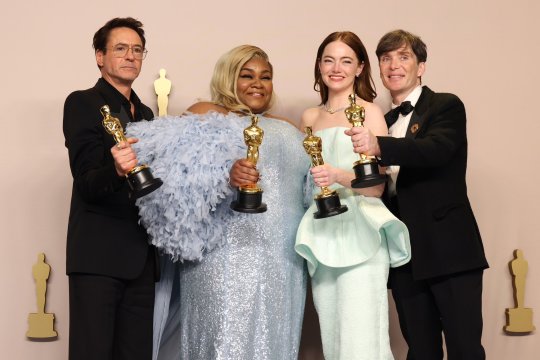
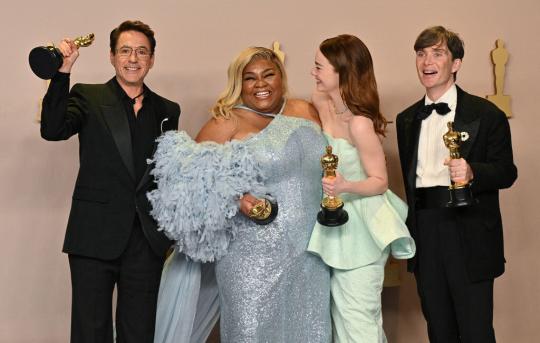
They have joined a great club.
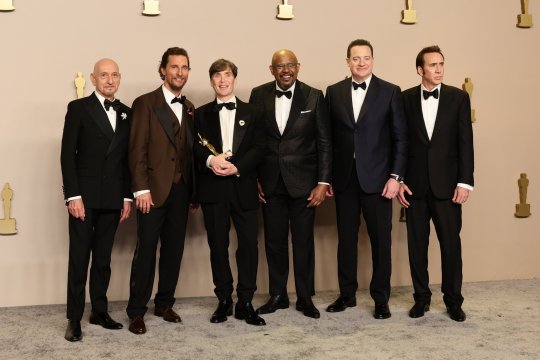
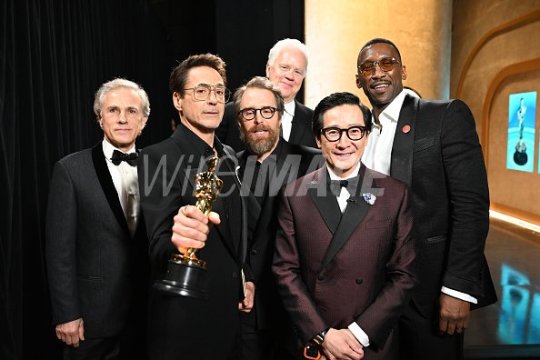

THEY ARE THE CHAMPIONS!
Best Picture OPPENHEIMER
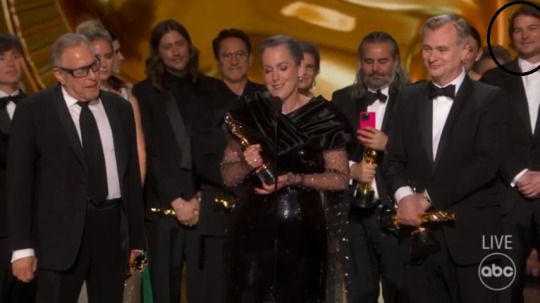
Best Directing Christopher Nolan
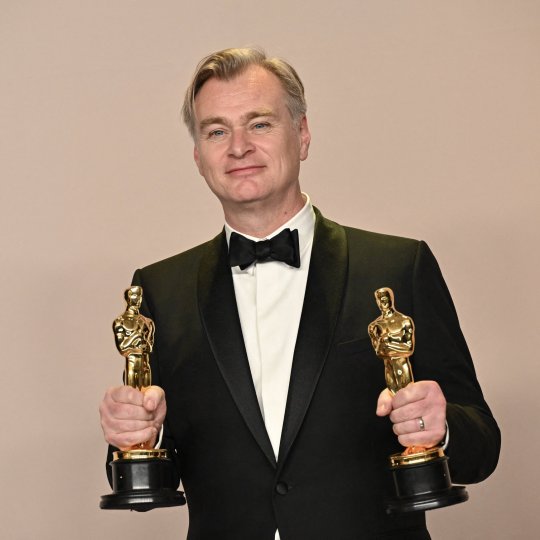
Best Actor in a Leading Role Cillian Murphy


The elusive Malachy Murphy on hand.

Best Actress in a Leading Role Emma Stone
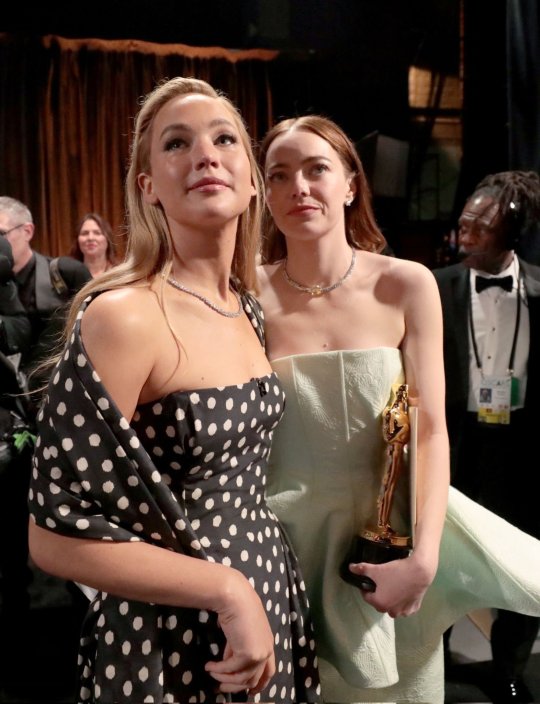

Best Actor in a Supporting Role Robert Downey Jr.

Best Actress in a Supporting Role Da’Vine Joy Randolph
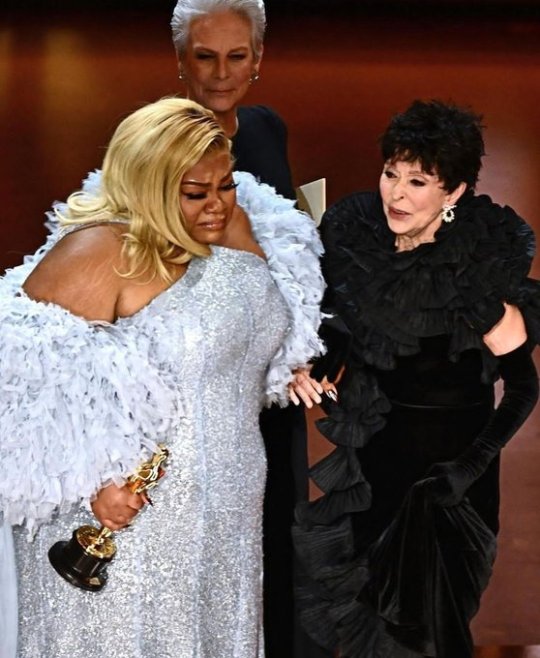
*Issa Rae peeping in.
Best Writing (Adapted Screenplay) American Fiction (Cord Jefferson)
Best Writing (Original Screenplay) Anatomy of a Fall (Justine Triet and Arthur Harari)
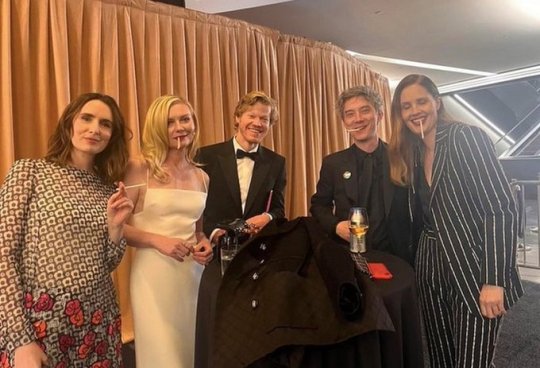
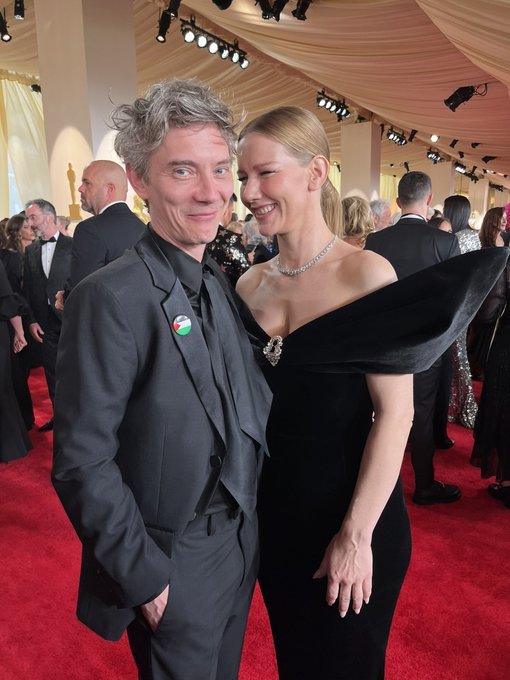
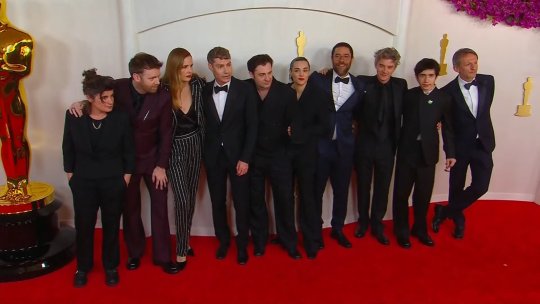
Best Animated Feature The Boy and the Heron
Best Documentary Feature Film 20 Days in Mariupol
Best International Feature Film The Zone of Interest
Best Animated Short Film War Is Over! Inspired by the Music of John & Yoko
Best Live-Action Short Film The Wonderful Story of Henry Sugar
Best Documentary Short Film The Last Repair Shop

Best Cinematography Oppenheimer (Hoyte van Hoytema)
Best Costume Design Poor Things (Holly Waddington)
Best Makeup and Hairstyling Poor Things (Nadia Stacey, Mark Coulier and Josh Weston)
Best Original Song “What Was I Made For?” from Barbie (Music and Lyric by Billie Eilish and Finneas O’Connell)

Best Original Score Oppenheimer (Ludwig Göransson)

Best Production Design Poor Things
Best Film Editing Oppenheimer (Jennifer Lame)
Best Sound The Zone of Interest
Best Visual Effects Godzilla: Minus One (Takashi Yamazaki, Kiyoko Shibuya, Masaki Takahashi and Tatsuji Nojima)

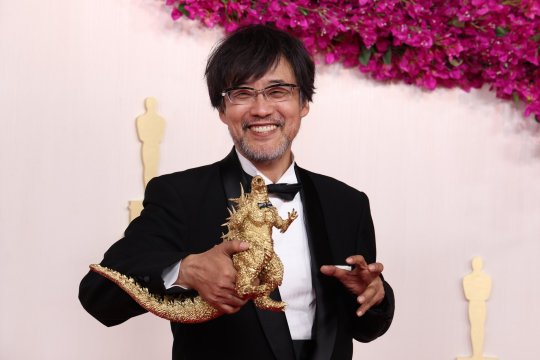
GODZILLA heels is extreme commitment to the bit.

#oscars#oscars 2024#oppenheimer#christopher nolan#da'vine joy randolph#emma stone#cillian murphy#robert downey jr#rdj#ludwig goransson#godzilla minus one#billie eilish#finneas#anatomy of a fall#justine triet#sandra hüller#swann arlaud#arthur harari
52 notes
·
View notes
Text
John Lennon by his friends and son: ‘He got eight years more than Jesus’
The former Beatle would have been turning 84 this autumn. Now his son Sean and those who knew him best are keeping his spirit alive with the rerelease of his classic solo album Mind Games
Everyone wonders what John Lennon could have become. When he was murdered in New York on December 8, 1980, the 40-year-old was in his post-Beatles prime. The superb album Double Fantasy had just come out and he was plotting a world tour. His second son, Sean, whom he took time off to bring up with his wife, Yoko Ono, was five, and Lennon was feeling inspired. Seven solo records since the Beatles had split ten years earlier; a reconciliation with Paul McCartney.
“Everyone gets the time they get, and he got eight years longer than Jesus,” says Bob Gruen, the rock’n’roll legend who took photographs of everyone who mattered in the 1970s. He captured Lennon and Ono’s time in New York and is confident and chatty — until conversation turns to what Mark Chapman took outside the Dakota that day.
“John should be alive now,” Gruen says, clearly still affected 44 years on. Gruen had spent the weekend with Lennon before he died and was developing his photos when he got the call. “He didn’t die in an accident or of a disease. His death broke my trust in everything. He was grounded at the time. He learnt a lot from raising his son, about enjoying his life and being sober. Then I heard he was dead.”
Lennon would have been 84 in October — and at least we are left with his songs. But legacy is complicated. Over the years McCartney has stolen his crown as chief creative in the Beatles. Partly because Lennon is no longer here to speak. Also because, during Peter Jackson’s 2021 film, Get Back, Lennon was largely stoned, while the charismatic McCartney conjured up magic. So to redress the balance, this month’s innovative rerelease of Lennon’s Mind Games (1973) pushes design and immersion in ways few box sets have before. It features new mixes — some that amplify Lennon’s voice, others that emphasise the instruments.
It is the work of Sean, 48, who has been at the forefront of the Mind Games rerelease. Lennon’s younger son is a musician and artist based in New York near his mother, 91. “The title track is one of the most beautiful songs ever written,” he says.
The songs answer questions Sean never got to ask his father. Despite being very young when his father was around, Sean does have memories of him — talking, watching TV, playing guitar and saying, “Good night, Sean.” The song Aisumasen (I’m Sorry) on the record is an apology from Lennon to Ono.
“One thing that distinguishes my dad’s solo career,” Sean says, “is how personal his lyrics became. It is like a diary, and it is my duty to bring attention to my father’s music. Not just my duty to him, but a duty to the world. With the world as it is now, people have forgotten so many things that I never imagined could be forgotten. I refuse to let that happen to this music — it means too much to me.”
Two years before Mind Games came out, Lennon moved to New York and met Gruen. Living in New York was simpler for him and Ono. They were hounded in Britain. “One paper called Yoko ugly,” Gruen recalls. “But in New York they were just treated as the quirky artists who came to town.”
Gruen’s eyes light up. “He was just funnier than everyone else,” he says. “I’d have loved him on Twitter, he was so cool with one-liners.” He smiles. “And, also, he learnt to cook. I’d always try to go to the Dakota for mealtimes.” What sort of food? “John used to be a meat and potatoes guy, but he met [the actress] Gloria Swanson in the vegetable store and she gave him a book that acted as a way into a macrobiotic diet from a western one. He got really into healthy food, baking vegetables and steaming fish.”
And this is the frustration. In the late 1970s Lennon was cleaning up his act. For himself, for Sean — a son he was involved with, as opposed to his first child, Julian. He had changed, from the man who went on his fabled “Lost Weekend” in Los Angeles in 1973. The weekend actually ran for months, during which Lennon left Ono, on Ono’s suggestion, for their assistant, May Pang, then 23. After Lennon went back to Ono, Pang carried on in the music business and married the producer Tony Visconti, but the Lost Weekend era remains her headline. During that time Lennon enjoyed chaotic recording sessions with Phil Spector. “I wondered if he’d ever make it back to New York,” Gruen says. “I thought he might get a place in Hawaii, or just die.” But Lennon returned in 1974, for his final six years.
What does Gruen think about how Lennon is remembered? Especially in Get Back? “Well, who’s the last one standing?” Gruen scoffs. “Who gets to write the history? The survivors get to write the history. That’s the way it goes.”
Tony King was the vice-president of Apple Records at the time of Lennon’s Lost Weekend. “We’re here to talk about my friend,” he tells me sweetly. King was out in Los Angeles working on a Ringo album when Pang phoned to say that Lennon needed help with his Mind Games record.
“I wasn’t looking forward to it,” King admits. “John could be sharp-tongued. But, in LA, he was super-friendly. I was straightforward. I told him he had to repair his reputation. After Imagine [1971] he’d gone in a different direction, making songs with a political edge. It was quite easy for John to get caught up in things. He had this tendency to see someone, decide he loved them and then go in their direction. I was lucky he went in my direction for a while. He realised he had lost some fans. Mind Games was more what people wanted.” Its songs were simpler and less political.
Personally, however, Lennon was in turmoil. “May on one arm, Yoko on the other!” King says. “He was juggling a lot.” Did Lennon talk about McCartney? “They were not getting along, but he was still fond of him,” King recalls. And what about that Lost Weekend era? “He was off the walls, to be honest.
“We went to Las Vegas and John interrupted Frankie Valli during a show, saying, ‘Get your cock out!’ We got thrown out and on the way back to the hotel he was pissing up against trees and then throwing his chips around the lobby. I put him to bed. It was difficult when he drank. John had taken way too much acid and so when he drank it flipped him into another style of person. One day it was great, the next it was very hard.”
King remembers the night his friend died clearly. “I was out at dinner in LA and the waiter said, ‘He’s dead.’ I returned to a very lonely, sad hotel room.” Does he ever think about what Lennon might have achieved later in his life? “Elton and I talk about John,” King says. He means Elton John. “We say, ‘I wonder what he’d be up to?’ Well, he’d have pounced on the internet and got into AI. And he’d still campaign. I could see him hopping on a plane to see Zelensky. He was a busy person, with an arresting personality. You’re never going to forget him.”
The Mind Games reissue is a beast, a lavish celebration of a fine, melodic rush of songs. Bonuses include the Ultimate Mixes, which bring Lennon’s voice to the fore; Raw Studio Mixes; there is a Super Deluxe Edition “presented in a 13in cube”; puzzles; and even an experience on the free Lumenate app that is described as a “consciousness-expanding psychedelic meditation” and uses the phone’s torch and Lennon’s tunes to guide users into “a state of consciousness between deep meditation and psychedelics”.
We are a long way from 1973 — when the session musicians David Spinozza, on guitar, and Ken Ascher, on keyboards, were asked to play on Mind Games. They recall the recording as efficient — Lennon left his partying for later. He was in a creative peak, with Mind Games his fourth album in three years since the Beatles.
“He was a Beatle!” Ascher says. “I was thrilled to get the call. Yoko told me, around 10pm, that John would like to meet. I called my wife and said, ‘I’m not coming home — I’m meeting John.’ He played me music he liked, and we talked for hours. His humour helped me relax.”
Spinozza worked with Lennon and McCartney in the 1970s. How did the men compare? “Paul would do one song for six hours, even for a day,” he says. “With John we never worked on one song for six hours. He worked quick — he was all business. I’m not saying one was better than the other, but Paul could work on a drum sound for hours. John just wanted to get it done.”
How does Sean feel about his parents, looking back? “Their story is a love story,” he says. “They found each other across a great divide and certainly struggled through ups and downs, but never doubted their love. It is important we remember them as an example. Even through rough patches you can see my father thought about my mother. They were simply, irrevocably intertwined.”
Lovely words — and as for John Lennon himself? “Generally it’s whatever comes out, like diarrhoea,” he once said of his recordings. “A bit personal, a bit political — someone told me Mind Games was Imagine with balls, which I liked. It was like an interim record between being a manic political lunatic back to a musician again.”
Speaking in the early 1970s, after a decade of super-fame, he said he did not feel different to how he had before. “I’m still a bit adolescent,” he said in one of his final interviews. “My old friends from Liverpool got jobs after school. I’d see them six months later and their hair would be thin and they’d be getting fat. They were becoming old men — while I just keep going.”
(source)
#god save me from mainstream beatles articles#still some interesting snippets#john lennon#sean lennon#paul mccartney
25 notes
·
View notes
Text
Types of Beatles fans
This has been done before but whatever The young fan: Probably from age 11-15, is just discovering classic rock. Famous for their "I'm born in the wrong generation" antics. Makes really bad memes and edits of the the Beatles and probably simps over George or John. McLennon shipper.
Old woman fan: Is an original Beatlemaniac from the 60s. Has really fond memories of the Beatles growing up and definatley simped for some/all of them. Likes early era beatles music best. Kinda odd but pretty nice
Old man fan: Also grew up with the Beatles, thinks all modern music is terrible and lacks all musical genius. Probably inspired by the beatles to play an instrument. Has very strong opinions about everything rock relates. Hates Gen Z, also hates Yoko Ono
Fan who hates the Beatles: Fan who goes out of their way to make fun of the Beatles all the time, and makes jokes about their music sucking. Hates at least one member of the beatles, if not all. Normally a really funny band kid
Scary old man fan: "Oh YoU'Re A FaN? NaMe FiVe SonGs ThaT TheY WrOtE" The aesthetic girl: Exclusively wears vintage outfits, owns a record player and approximatley $300000 worth of records, as well as 10 beatles posters. Probably saw Paul or Ringo live. Solo album fans: Loves All Things Must Pass and Ram. Refuses to listen to Plastic Ono Band. Thinks revolution 9 is a masterpiece.
Paul Lesbians: Hates men but makes an exception for Paul. Definitely has gone to a concert. Also likes Roger Taylor
Middle aged music teachers: "GUYS LISTEN TO THE BEATLES THEY'RE GOOD MUSIC"
Regular fan: Owns an Abbey road shirt and doesn't participate in the nightmare of the fandom.
#the beatles#roasting#paul mccartney#george harrison#john lennon#ringo starr#1960s#fans#types of fans#yoko ono#abbey road#all things must pass
120 notes
·
View notes
Note
What's ur top five for the mclennon evidence tier
Depends from whose perspective, so I'm dividing them up
(and I feel this demonstrates why I have very different opinions on who had feelings for whom; if someone disagrees they're welcome to argue with me [I like that lol] but it really comes down to what type of evidence I find more convincing)
John
1. His Widow Literally Saying It? You know, THE quote:
From chance remarks he had made, she [Yoko] gathered there had even been a moment when—on the principle that bohemians should try everything— he had contemplated an affair with Paul, but had been deterred by Paul’s immovable heterosexuality. Nor, apparently, was Yoko the only one to have picked up on this. Around Apple, in her hearing, Paul would sometimes be called John’s Princess. She had also once heard a rehearsal tape with John’s voice calling out “Paul … Paul …” in a strangely subservient, pleading way. “I knew there was something going on there,” she remembers. “From his point of view, not from Paul’s. And he was so angry at Paul, I couldn’t help wondering what it was really about.”
2. 1972 Sandra Shevey interview:
I wanna be clear like. THIS is BY FAR the best evidence. I will list more, but nothing else really comes close to the above quote. There is zero interpretation needed (or room to take it as a joke) and it's coming from about as close a source to John as possible.
The only thing ever lacking in working with another artist and they were usually male - whether it was Stuart Sutcliffe (my art school friend) or Paul McCartney (my musical friend) - is that the relationship only goes as far as the front door and after that you are alone in bed. It's a plus not a minus. The plus is that your best friend, also, can hold you without… I mean, I’m not a homosexual, or we could have had a homosexual relationship and maybe that would have satisfied it, with working with other male artists. [faltering] An artist – it’s more – it’s much better to be working with another artist of the same energy, and that’s why there’s always been Beatles or Marx Brothers or men, together. Because it’s alright for them to work together or whatever it is. It’s the same except that we sleep together, you know? I mean, not counting love and all the things on the side, just as a working relationship with her, it has all the benefits of working with another male artist and all the joint inspiration, and then we can hold hands too, right?
3. David Sheff insanity feat. Yoko:
JOHN: Well, that’s rubbish, you know. Because nobody controls me. I’m uncontrollable. The only one that can control me is me, and that’s just barely possible. [Yoko laughs] But that’s what life is about. And that’s the lesson I’m learning. Because – nobody ever said anything about Paul having a spell over me, when I was with him for a long time. Or me having a spell over Paul. They didn’t think that was abnormal, two guys together. JOHN: Or four guys together. In those days? Why didn’t anybody ever say, “How come those guys don’t split up? I mean, what’s going on backstage? I mean, what is that Paul and John business? Why – you know, how can they be together so long?” YOKO: They might have. [laughs]
These next ones are again a tier below. The above three are eyebrow-raising independent of each other, but the below two sort of require the above three to feel like they've got argumentative weight IMO.
4. "It's just handy to fuck your best friend."
5. 1974 self-interview.
The last one is a good example of what I meant here. The self-interview could be much more easily dismissed as a joke if the above points didn't also exist.
Stuff like John marrying Yoko immediately after Paul married Linda is interesting when considering John having feelings for Paul, but I don't think it would constitute evidence in isolation. I think it's important to differentiate events which take on a very specific meaning when you make a (perhaps reasonable) presupposition from things which directly imply said presupposition. I also find the fact that there's an incredibly strong case for John experiencing attraction to men who are not Paul – while not evidence for McLennon per se – significantly increases the likelihood that the above quotes are pointing to real feelings for Paul.
(also notice how none of these are song lyrics lol – songs would almost always fall under that idea of something which might take on a connotation, given biographical context, but can almost never be seen as evidence of something on their own)
Paul
1. That "Maybe if I had been a woman I could have–" quote. I don't have the exact phrasing handy, but you know the one.
2. Generally how defensive Paul has historically been about John's sexuality. This is completely circumstantial, but I agree it's a reasonable reading of Paul's behaviour.
The above two points are by far the biggest arguments for Paul IMO though they are notably not as directly linked to the idea of Paul having feelings for John as my John quotes were (which doesn't mean Paul being in love with John is impossible, of course).
The next stuff doesn't really convince me at all but I still think it's the best:
3. His general reaction to JohnandYoko*
4. Paul going off about John's looks a lot.**
5. I guess lyrics lol. Dear Friend and However Absurd are probably the best ones. Honourable mention to the "I find my love awake" verse of Too Many People.
*I'm actually a fierce believer in the concept that a) JohnandYoko were not a normal couple so this isn't just a simple case of being upset at your bestie getting a partner and it's imo willingly obtuse to act like that's what was happening and b) even then, platonic jealousy is not unheard of. But I certainly recognize that it could be a sexually-driven jealousy.
**Gay men and straight women will fawn over women's looks and talk in much more sexually charged language than Paul about John. Sure, "it's different for straight men", which is why I'll grant it, but just something to think about as well.
The Paul stuff looks a bit half-hearted – because it is, but I did spend a lot of time trying to think of stuff. If you can think of something you personally find more convincing than any of these points, feel free to send it over and I'll tell you how I would "rank it" and why. It's possible I'm forgetting something that deserves to be up there.
Last point, but I actually think it's really important to be able to more or less rank evidence of one's own beliefs. And of beliefs one doesn't hold.
#i separated the two out because if i didnt#there would only be john here. lol#ask#anon#jp speculation#my analysis
25 notes
·
View notes
Text
The Great Covid Beatles Binge, Day 2: Give My Regards to Broad Street
Hoo boy, here we go!

OK so we open with a stern/bored looking Paul stuck in traffic in the rain and it looks like he's spacing out... hey, Paul, are you starting to daydream? Paul? Is this whole movie about to be a dream, Paul? Oh god

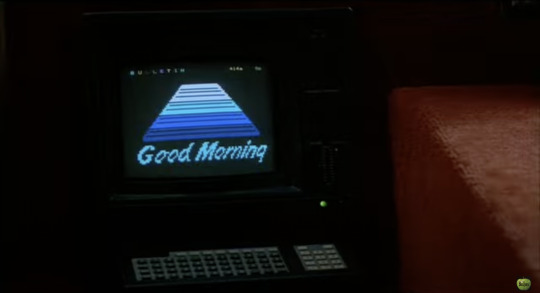
This silly little car! The computer, the carpet, the pool ball gear shift. It's giving the 80's car version of the Beatles house in Help! It's also giving hyper-masculine in a way that is, I'm sorry, not convincing.
This plot is already deeply inscrutable. Something about some missing tapes, a reformed criminal that Paul knows somehow and trusts for some reason, and some ominous business men. Something bad will happen at midnight if the tapes aren't found. OK!
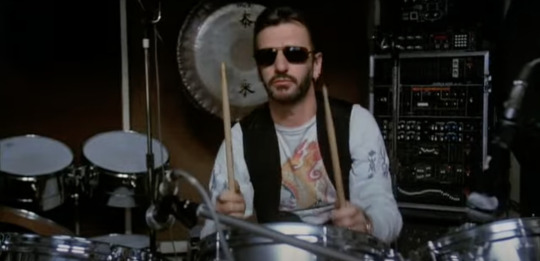
Ringo looks so cool and hot! That vest over that sick as hell dragon shirt. Yes. This scene is genuinely funny, too -- Ringo spends the entirety of "Here, There and Everywhere" and "Yesterday" searching through his mountains of drum equipment looking for brushes, only to find them too late. Apparently, the reason for this scene is that Ringo just didn't want to re-record old Beatles songs!
And now we have Paul, Ringo, George Martin and Geoff Emerick all together in a scene! Makes me think about how George Harrison apparently was a little miffed Paul didn't just call him to ask for filmmaking advice since it was something he had experience with. What could have been!
“Wanderlust” is such a great song, actually, damn.
“I’m not a bad boy, really. I’m just — er, manipulated” John??
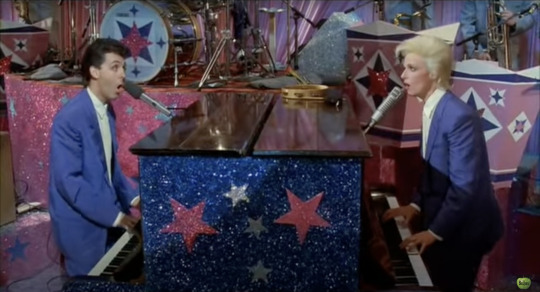
Now this is more like it! Surprise Linda in drag, hell yes!
I don't know why this scene is happening? It's a rehearsal for... something? But I'll take it. I love "Ballroom Dancing" and I love vaudeville Paul.
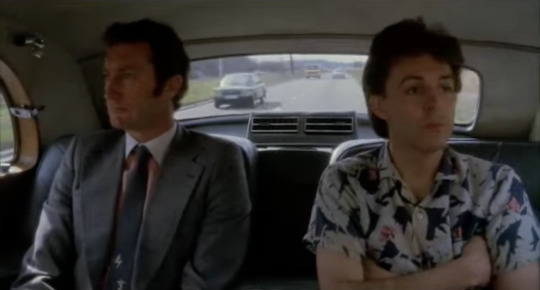
I'm starting to feel like Paul's grandpa in AHDN, "so far, I've been in a train and a room, and a car and a room, and a room and a room." Did Paul's experience on that set define what a movie is to him? "Ah yes, a movie must include lots of transportation from one location to another and then some musical scenes." But dear, it worked because there were jokes! And all four of you to play off each other.
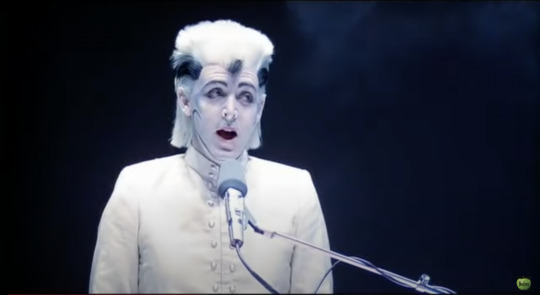
I.......... what
This is Silly Love Songs, of all things!
Again, I don't know why this scene is happening in the context of the movie. Is it another rehearsal for something? A music video? Television special? Who knows, Yoko! But OK here we go, I sure am having fun! Linda is extremely into it. That slap bass kills. There's a Michael Jackson impersonator for some reason? Sure! It makes no sense but I love this man and his bizarre beautiful mind.

So now we're doing band rehearsal in some kind of barn? Or abandoned warehouse? Or something? All of the plot of this movie seems to happen in dialog in cars en route to some ambiguous musical engagement.
“Do you think we can get some heat in here or are we practicing to be Canadians?” God bless you, Ringo.
“Should we try Not Such a Bad Boy” “Do we have to?” “Yeah” Bossy Paul bosses around a Beatle, we love to see it.
Is this song about him or John?
The French horn player coming in late to record "For No One," inexplicably in a bright red motorcycle helmet, so late that he’s preparing up until right before the solo starts. Reminds me of that story of Ringo recording Hey Jude. But it also feels very symbolic of something. There are so many odd inscrutable details in this movie, it could almost be Lynchian in someone else's hands.
“We’re running, and running out of time too” It feels meaningful but I don't know how.

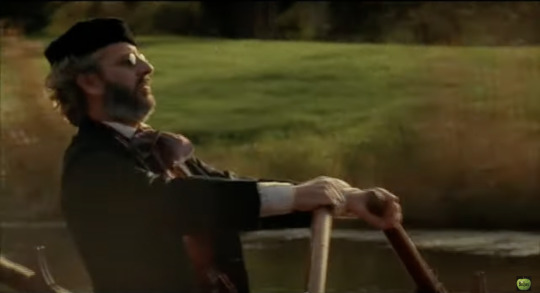
Hello Mr. Darcy! Wow, can I have an entire movie that’s just this Victorian dream sequence? Can we go back in time and do a Beatles movie period piece, please??
The strings in this which are inspired by but are not quite "Eleanor Rigby" are lovely. Apparently this whole sequence is called "Eleanor's Dream," which implies that Paul is Eleanor. Make of that what you will, I suppose.
I like that Linda is a pants-wearing photographer in this period scene. Linda's gotta Linda.
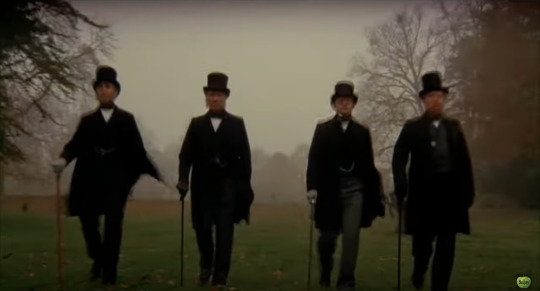
This strikes me as very Evil Beatles. Again, make of that what you will.
Barbara and Linda are acting the HELL out of this going over the waterfall scene damn.
I don't know, I could screen grab this entire segment, it's amazing, it's insane.

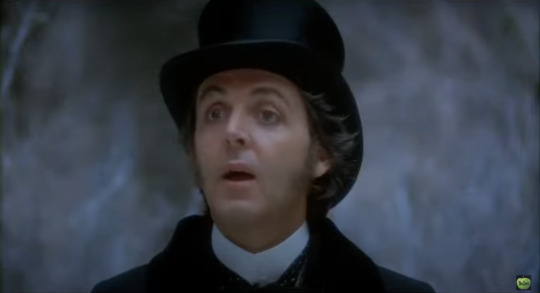
But I can't gloss over Paul being horny for Ghost Horse Girl Linda. Incredible.
"That’s it you’re finished. What are you gonna do now?" Well ok at least this one is pretty obviously a reference to the critical reception of his career after the Beatles and again after John.

"Uncle Jim" Ok so I guess this is supposed to be his dad, but what is the point of this scene? And why the monkey? The further I get into this film the more I feel like I am looking deep into this man's psyche but through the murkiest of windows. I'm here for the weird dream symbolism, Paul, but if you're gonna go that route, again go full Lynch and get even weirder.
Just the straight up original recording of "Band on the Run" feels out of place with all these re-records. I wonder why that choice.
His car license plate is "PM 1" That's right, baby, you're number 1.
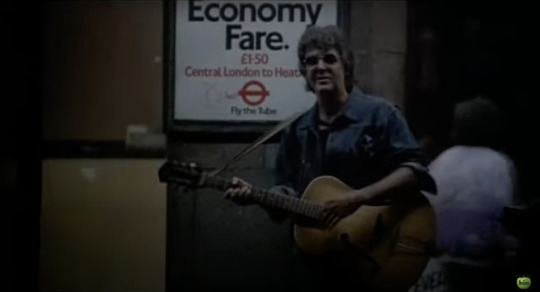
Another little cute but inconsequential day dream (presumably within the dream that is this entire movie). He looks like Roy Orbison here.
Oh ok Harry was just locked in a cupboard this whole time. So the whole "plot" was pointless. Cool cool cool.
Paul and Harry being giddy and laughing together is cute though, and it makes me wish that that relationship was fleshed out more. Who are they to each other, exactly??

Yup it was all a dream. Love it, love that for us. Thanks, Paul.
OK so this was definitely barely a movie. There could have been something here, but I'll go back to what I said above -- I wish he'd gone weirder with the whole thing! And I wish Paul himself had been weirder. The character Paul is kind of a dud, just plodding along from place to place and only coming alive when he performs. It's like that Hawaiian shirt is supposed to be a stand in for characterization. But worth it for the music video scenes and for getting a tiny glimpse into Paul's psyche.
31 notes
·
View notes